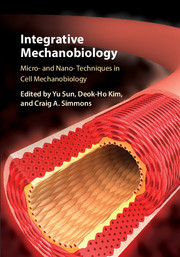Book contents
- Integrative Mechanobiology
- Integrative Mechanobiology
- Copyright page
- Contents
- Contributors
- Preface
- Part I Micro-nano techniques in cell mechanobiology
- 1 Nanotechnologies and FRET imaging in live cells
- 2 Electron microscopy and three-dimensional single-particle analysis as tools for understanding the structural basis of mechanobiology
- 3 Stretchable micropost array cytometry
- 4 Microscale generation of dynamic forces in cell culture systems
- 5 Multiscale topographical approaches for cell mechanobiology studies
- 6 Hydrogels with dynamically tunable properties
- 7 Microengineered tools for studying cell migration in electric fields
- 8 Laser ablation to investigate cell and tissue mechanics in vivo
- 9 Computational image analysis techniques for cell mechanobiology
- 10 Micro- and nanotools to probe cancer cell mechanics and mechanobiology
- 11 Stimuli-responsive polymeric substrates for cell-matrix mechanobiology
- Part II Recent progress in cell mechanobiology
- Index
- References
7 - Microengineered tools for studying cell migration in electric fields
from Part I - Micro-nano techniques in cell mechanobiology
Published online by Cambridge University Press: 05 November 2015
- Integrative Mechanobiology
- Integrative Mechanobiology
- Copyright page
- Contents
- Contributors
- Preface
- Part I Micro-nano techniques in cell mechanobiology
- 1 Nanotechnologies and FRET imaging in live cells
- 2 Electron microscopy and three-dimensional single-particle analysis as tools for understanding the structural basis of mechanobiology
- 3 Stretchable micropost array cytometry
- 4 Microscale generation of dynamic forces in cell culture systems
- 5 Multiscale topographical approaches for cell mechanobiology studies
- 6 Hydrogels with dynamically tunable properties
- 7 Microengineered tools for studying cell migration in electric fields
- 8 Laser ablation to investigate cell and tissue mechanics in vivo
- 9 Computational image analysis techniques for cell mechanobiology
- 10 Micro- and nanotools to probe cancer cell mechanics and mechanobiology
- 11 Stimuli-responsive polymeric substrates for cell-matrix mechanobiology
- Part II Recent progress in cell mechanobiology
- Index
- References
Summary
The migratory ability of various cell types contributes to cell functions, physiological processes, and disease pathologies. Among the diverse environmental guiding mechanisms for cell migration, the electric field is a long-known important guiding cue. The electric field–directed cell migration, termed “electrotaxis,” can mediate processes that are important for human health such as wound healing, immune responses, and cancer metastasis. The growing interest in better understanding electrotaxis has motivated technological developments to enable more advanced electrotaxis studies. In particular, various microengineered devices have been developed and applied to studying electrotaxis over recent years. In general these new experimental tools can better control electric field application in cell migration experiments, whereas each developed tool offers its own features. Successful applications of the new devices have been demonstrated for studying electrotaxis of various cell types such as cancer cells, lymphocytes, animal models, and tissue cells related to wound healing, as well as for investigating electric field–mediated orientation responses in stem cells and yeast cells. In this chapter, we will provide the background information in directed cell migration, electrotaxis, and cell migration assays. We follow with a survey of fabrication and assembly methods of various microengineered electrotaxis devices and experimental setup and analysis methods, as well as their applications for cell studies. Finally, we conclude the chapter with our perspective on the issues challenging this research area and on the proposed directions for future development.
Information
- Type
- Chapter
- Information
- Integrative MechanobiologyMicro- and Nano- Techniques in Cell Mechanobiology, pp. 110 - 127Publisher: Cambridge University PressPrint publication year: 2015
